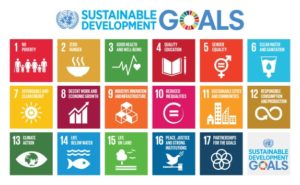 Today, 17 October, marks the 25th International Day for the Eradication of Poverty. The reduction and eradication of poverty and achievement of development goals is often closely linked to human rights rhetoric – but how, and why, are they connected?
Today, 17 October, marks the 25th International Day for the Eradication of Poverty. The reduction and eradication of poverty and achievement of development goals is often closely linked to human rights rhetoric – but how, and why, are they connected?
To explain the important links between the eradication of poverty, development and achievement of human rights goals, we spoke to Camilla Silva Fløistrup, Senior Legal Adviser at the Danish Institute for Human Rights (DIHR), an independently operating state institution which holds the legal mandate as a National Human Rights Institution (NHRI). DIHR has a 20-year track record in human rights development work around the world, as well as a highly acclaimed research department combining academic research with the practical experiences derived from working with partners on the ground. In addition, the DIHR applies a human rights-based approach and has built analytical and practical capacity in a wide range of human rights fields, including the linking of sustainable development goals and human rights.
The DIHR is leading a module on Human Rights and Development for the Human Rights Consortium’s MA in Understanding and Securing Human Rights by distance-learning, equipping students to understand the conceptual, legal and practice-based links between human rights and development.
How are the reduction and/or eradication of poverty and the achievement of human rights goals linked?
Reduction/eradication of poverty is closely connected to development and human rights provide norms that serve to couch policy goals and orientations in development efforts.
As noted in Human Rights and Development in the New Millennium: Towards a Theory of Change (eds: Paul Gready, Wouter Vandenhole)*, “Human rights values are often invoked in development or changing social norms contribute to human rights value changes that affect development practices and organizations […] Actors invoke values to legitimize action, and the perpetual reference to human rights may also serve to reinforce the role of rights in development.”
Human rights principles overlap with good governance criteria. This is the case for the principles of participation and accountability. The human rights principles agenda drives accountability citizenship as part of operational policies. Nonetheless, many development actors still need to use human rights principles connected to non-discrimination, inclusion and equality to reach the most disadvantaged groups of society. By using human rights, we ensure that the most vulnerable in each society can be reached.
Why is it useful to conceptually link together human rights and social justice?
Human rights is also about changing social structures and transforming the power dynamics to ensure that all in society have access to all human rights.
Human rights is also about changing social structures and transforming the power dynamics to ensure that all in society have access to all human rightsEven though, many times the human rights discourse might have been closer connected to individual rights connected to trials or elections, it is the work on Human Rights Based Approach that actually looks into changing the power dynamics of societies, like social justice work does.
Human Rights and Development in the New Millenium notes that “Human rights-based approaches do have a positive impact on equality and poverty reduction. Examples of situations where human rights has been integrated into development policies, and where human rights integration results in positive change can be found in gender policies, social sectors, behaviour change, migration policies, land rights, and private sector engagement with surrounding communities and societies.”
Human rights-based approaches have a positive impact in development because: a) human rights contributes to empowerment and social protection of marginal groups; b) human rights reinforces work on non-discrimination and equality, raising a demand for disaggregated data; and c) human rights brings attention to legal approaches.
What are the connections between human rights, decolonisation, and international development aid?
 The international human rights agenda gains force in the 1950s and 1960s, at the same time as decolonisation processes in the world gain power. Many former colonies used human rights discourse, mostly the initiatives connected to equality and non-discrimination. In the 60s, developing countries that had recently become independent were champions in advocating for the adoption of international human rights conventions and asking that the human rights agenda be disconnected from Cold War politics. Development aid had its own agenda for some decades, but from the 1980s, with the adoption the UN Declaration on the Right to Development, the two fields started to converge and human rights and development have started focus more on similar issues. Human rights has become part of development. UN agencies, bilateral donors, international NGOs, and local partners are using human rights to tackle development issues. In the poorest countries and in middle-income countries, human rights has guided different approaches and initiatives in order to improve people’s lives and a human rights-based approach has set focus on the relationship between the state and its citizens.
The international human rights agenda gains force in the 1950s and 1960s, at the same time as decolonisation processes in the world gain power. Many former colonies used human rights discourse, mostly the initiatives connected to equality and non-discrimination. In the 60s, developing countries that had recently become independent were champions in advocating for the adoption of international human rights conventions and asking that the human rights agenda be disconnected from Cold War politics. Development aid had its own agenda for some decades, but from the 1980s, with the adoption the UN Declaration on the Right to Development, the two fields started to converge and human rights and development have started focus more on similar issues. Human rights has become part of development. UN agencies, bilateral donors, international NGOs, and local partners are using human rights to tackle development issues. In the poorest countries and in middle-income countries, human rights has guided different approaches and initiatives in order to improve people’s lives and a human rights-based approach has set focus on the relationship between the state and its citizens.
How are the UN Sustainable Development Goals linked to international human rights law and to securing human rights in national frameworks?
In September 2015, the United Nations General Assembly (UNGA) adopted the Sustainable Development Goals (SDGs). The SDGs are critically important as most international development efforts, from 2016 until 2030 —including those of donors, major development institutions, national governments and civil society—will likely be directed toward achieving these goals. The seventeen goals address poverty eradication, food security, education, gender equality, health, work, and other areas of human development, as well as economic growth, natural resource governance, and environmental protections. Each SDG is implemented via specific targets as well as indicators to measure progress toward each target.
The 2030 Agenda, which contains the SDGs, is explicitly grounded in the Universal Declaration of Human Rights and international human rights treaties. The commitment to non-discrimination and to “leaving no one behind” is a reflection of this foundation in human rights. Additionally, the commitment to human rights is reflected throughout the goals and targets. The implementation of the Agenda 2030 lends itself to a HRBA, as it in many ways is based on HRBA principles for its implementation. Inclusion is a concept, which has become more prominent with the HRBA and is now strongly grounded in the SDGs goals and targets.
Human rights instruments and the 2030 Agenda are tied together in a mutually reinforcing way. Human rights offer guidance for the implementation of the 2030 Agenda, while the SDGs in turn contribute substantially to the realization of human rights.
*see working papers and policy briefs related to this work in the Human Rights Consortium’s SAS-Space collection.
Save
Save

